|
You are reading the older HTML site
Positive Feedback
ISSUE
20
I have heard the Future of Audio …and it is
Digital: The PS Audio GCC Integrated Digital Power Amp
I didn't say that. John Atkinson did, in a Stereophile editorial from April of 1994, as usual hyping the latest breakthroughs: "digital technology has finally surpassed the sound quality of analog." My own ears didn't agree with Stereophile's back then, and I continued buying up all the vinyl I could find and afford. Realizing there was this weird kind of brotherhood out there, mostly middle-aged guys haunting used record shops and sweeping yard sales free of Blue Notes and Shaded Dogs, I spent the last half of the ‘90s publishing Primyl Vinyl, a newsletter devoted to audiophile record collecting. Alas, that adventure fell victim to it's own success—as the subscriber list edged over 1000, it became impossible to write, Xerox, staple, and mail the damn things on schedule and maintain anything like normal work, family, and leisure commitments (like going to used record shops and yard sales). Atkinson was, of course, just riffing on Jon Landau's legendary/infamous line vis-a-vis Bruce Springsteen being the future of Rock and Roll. Actually, what Landau had actually written almost exactly twenty years before Atkinson is a bit more interesting with a little context:
I gotta say, that last sentence seems to me to be what the pursuit of high end audio at a certain age is all about. I also gotta say, I was There. Then. May 9th, 1974, the Harvard Square Theater, center orchestra, two thirds of the way back …to see Van Morrison. Yes, Van the Man was the headliner, and the intro act was (if memory serves) Bonnie Raitt. The filler act was "This band from Jersey, hear they're pretty good." The Boss Killed. Audiences have come to expect a 2-3 hour adrenalin rush from a Springsteen performance, but back then the crowd was stunned and emotionally exhausted when Morrison finally staggered to the stage. After no more than 45 near incoherent minutes, with a substantial segment of the audience heading for the aisles, he mercifully fell victim to the curfew and the last subway to Boston. OK, so why all the history? Because I have heard the Future of Audio …and it is Digital. Sort of. I am still an analog guy when it comes to recording formats—though SACD goes a long way to redeem the promise of Sony's ill-considered boast of "Perfect Sound Forever." I'm referring to my experiences with the PS Audio GCC 100, a "second generation" digital amplifier, and there is some relevant history there too. PS Audio founders Paul McGowan and Stan Warren reportedly first got together in that same Summer of ‘74, and their first product was an outboard phono stage they retailed for a whopping $59.95. They probably demoed the thing with The Wild, the Innocent, and the E Street Shuffle. Ever since, PS Audio has had the reputation amongst savvy audiophiles for high-value and innovative products such as the first outboard DAC, the Digital Link. More recently, PS Audio simply reinvented power conditioning with the AC regenerating PS300 Power Plant, and currently offers the industry's broadest range of AC management devices. PS Audio also made power and preamps over the years—the PS Audio 2C of the ‘80s was long a beer budget cult fave. Stan Warren would eventually leave to start the similarly bargain-budget Superphon (one of his Revelation pre-amps remains on my back-up shelf) and McGowan himself left to join forces with Arnie Nudell (ex-Infinity) to start Genesis Technologies. Where he apparently also learned something about the importance of industrial design, for when he returned to a flagging PS Audio in the late ‘90s, their products began to sport a much sexier look than the basic black box boredom of yore. And it turns out he had a few other ideas culled from Nudell's Infinity scrapbook in the back of his mind. In 2002, PS Audio introduced the HCA-2 power amplifier, garnering a coveted Class A rating from Stereophile (OK, with a few staff cavils), and at $1695 dramatically undercutting all the mega-buck offerings in that section. It was not the first "digital" amp (Tact and Spectron come to mind), and in fact marketing realities probably led them to downplay the digital aspect. While the mass-market consumer seemed eager to buy anything "digital", the problems with Red Book CD sound had made many audiophiles more than skeptical of the D-for-Dirty word. HCA stood for Hybrid Class A, an audiophile-friendly nod to Bascom King and Arnie Nudell's tube/solid state hybrid design for Infinity back in …the 70s. Key to that earlier design was using tubes for the voltage stage and transistors for the current stage, allowing the strengths of the two technologies to work synergistically. In the HCA-2 the role of the tube stage was taken by a JFET based analog input stage, and the output by a Class D digital switching amp. I.e., a new kind of hybrid. There were a number of very favorable reviews of the HCA-2, but John Zurek's at https://positive-feedback.com/Issue9/hca2.htm does an excellent job of explaining the logic behind the technology (as does the PS Audio website), so I won't recover much of that here. However, let me hasten to assure you that there is nothing inherently superior about "Class A" versus "Class D" or whatever-the nomenclature distinguishes circuit designs rather than ranking them. If you have a sub-woofer, odds are it has a Class D amp built in. One of the virtues of the technology is that the circuit can be very compact and still run very cool, both good ideas for a wooden box tucked behind the couch. Class D amps are referred to as "digital" because they typically use Pulse Width Modulation (PWM) to construct the signal that drives the loudspeakers. PWM as opposed to the Pulse Code Modulation (PCM) system used in CDs and DVDs. PCM is a stream of measurements of amplitude, the Red Book CD standard being 44K samples at 16 bit resolution accuracy. To improve PCM quality, one needs more samples and/or more bits. Hence, 24 bit/196kHz DVD-A. PWM is a stream of simple on/off (that is, 1-bit) signals at an extremely high rate (like 350kHz). Some of the spontaneous dread that the word "digital" can elicit might be ameliorated by noting that SACD is also a PWM process. Now, only three years later, PS Audio has replaced the 150wpc HCA-2 with a full line of new amps they say are better still: the GCA100, GCA250, and GCA500 power amps and the GCC cousins they call "Control" amplifiers. The number indicates the wpc into an 8 Ohm loudspeaker; you can double it if you have 4 Ohm speakers. So what are the differences between the old "new" and the new "new"? The output stage of the HCA-2 was described as "digital" and "trademarked" SDAT (Super Digital Amplifier Technology). The PWM output stage in the new PS Audio models is described on part of the site as a SDAT, but elsewhere they emphasize that it is an analog circuit. The idea remains using the output transistors to switch on and off at very high rates (the pulses) rather than vary continuously the signal to the speakers. Transistors are basically switches, and tracking complex waveforms is not really their forte. Tube amps sound different than solid state largely because, as the Brits correctly describe them, they are valves, and do the signal variation thing very well. Now, there is an unrelated SDAT audio company out there, but I don't really know if this is a legal thing, a technical change, or anything other than marketing digiphobia. A PWM amplifier requires filtering to smooth the pulses into an analog waveform and remove above-audio-band noise from the output (not an easy task given the varying impedance of typical loudspeakers). Such filters can also compromise the damping factor of the amplifier, i.e. the ability of the device to control the woofer cone at low frequencies. PS Audio maintains they have devised a load-invariant filter, and their amps are now stable and sonically consistent into any loudspeaker. Furthermore, the damping factor, a respectable 100 or so for the HCA-2, is claimed to be over 1000 in the new GCA/GCC series. Watch out woofers, we gotcha by the voice coils. Yes, the new models are still something of a hybrid design, but with a twist. The "GC" stands for Gain Cell. The HCA-2 used "a perfect voltage gain stage" using JFETs and a separate power supply. The new products employ a small (1" x 3") sealed module-the Gain Cell-at the input. To quote from the PS Audio web page:
In the new power amps, the Gain Cell is placed at the input (in fact, the RCA jacks are attached directly to it), and set for 27dB gain to feed the PWM output stage. In the GCC "Control" amps, the gain is variable over a 130dB range by front panel knob or remote, and there is a choice of five inputs (one balanced, 4 RCA). PS Audio stresses that the GCC is not your classic "integrated" where the input signal is first amplified to a fixed degree, and then attenuated by a potentiometer (which thus throws away much of the signal). They claim the GCC represents the shortest and simplest audio path ever built (and here you thought that was a tweaky 47 Lab kind of thing). And should you only want a preamp, the PS Audio GCP preamps have just the variable Gain Cell and input selector-no traditional volume control as such at all. Compact and cool-running, the Gain Cell + Class D approach is a natural for multi-channel amps: check out the GCA-MC 5 and 7 channel models if that's your interest. In fact, the Gain Cell module could be dropped into a CD player, headphone amp, mixing console, or what have you; even a phono stage I suspect, as the input impedance is 47K ohms, if and when McGowan can find the schematic for the passive RIAA network he designed in 1974… I started thinking about digital amps when I moved from Boston to Albuquerque last August. For years, I had run tubes in the winter and solid state in the warm months. In the desert, though, one does anything one can to avoid turning on the swamp coolers. See, we don't have sissified air conditioners out here—we strap a big ol' humidifier on the roof and spray water into the dry air we blow into houses made of mud. Works kind of like kids scampering through sprinklers. But the "swamps" are noisy, and one of the appeals of adobe is how low the ambient noise floor is. Much as I love ‘em, tube amps are about 10% efficient (i.e., 90% heat), Class A solid state but a little better. Typical Class A/B transistor amps run maybe 50%. PS Audio suggests the GCA/C design is like 90% efficient, drawing perhaps 10 watts at idle. That means even my buddy living "off the grid" way up outside of Taos could leave it on standby without the solar panels even noticing. I had actually requested the GCA 100 power amp for review, as I like my Herron Audio VTSP-1A tube preamp just fine—it mates so nicely with the Herron VTPH-1 phono stage. Imagine my surprise when I lifted the unit from the shipping container. Well, the first surprise was that it weighed less than 30 lbs. Second jolt: there was a knob on the front. Slowly it dawned on me that this was the "integrated" GCC version, not the plain GCA power amp. I was going to send it back until I noticed the remote had a button labeled "Phase." Clark Johnsen would never forgive me if I had just packed it up. So I contacted PS Audio to make sure I didn't have someone else's unit, and allowed as how I'd somehow make do. Clark, the author of The Wood Effect and contributor to PFO, is the Avatar of Absolute Phase, and he had plenty of opportunity while I was in Boston to sensitize me to the issue. In essence, there is no standard polarity for recordings, so statistically 50% are in inverted polarity and sound kind of "muffled" until the polarity (or phase) is reversed. While a Phase inversion button became standard on outboard DACs, my vinyl-biased system lacked any facility for this other than swapping the speaker leads. Yippee, I thought! On the other hand, I was dismayed at the absence of a mono button. Bummer!
PS Audio is quite proud of their massive, custom speaker terminals designed to lock in banana plugs. Nordost is equally enamored with their bespoke thin wall "better than banana" Z-plugs. Of course, in practice, the two had one of those awkward first time male-won't-fit-in-the-female things. In fact, I managed to snap off one of the Z-plugs on my Red Dawn II cables while trying to swap them around. Nordost promptly re-terminated it, but fellow klutzes be aware. Conventional bananas are OK, and probably the locking WBT style too. Spades? The location of the hunky terminals is another ergonomics gripe. We have the EEC to thank for banishing the old style 5-ways with the standard ¾" spacing, but it was PS Audio's idea to offset the terminals 2" and at an angle (I suspect to clear the Gain Cells). The lowered inner terminal makes it very difficult to fit a spade terminated stiff or heavy cable from below, and the input jacks block coming down from above once interconnects are plugged in. On the right channel, the IEC AC socket also limits connection options. Bottom line, stick to conventional bananas.
The GCC100 comes supplied with a generic AC power cord, but PS Audio kindly provided one of their best upgrade cords, and the improvements were not subtle. I ran in the amplifier for 75-100 hours on test tones and music, rotating speakers and cables before doing serious listening. So, finally, howzitsound? That's the toughest question to pose for a power amp, as its only task is to increase (but otherwise not change) what it is given and pass that along to another device that can actually do something with it. In other words, Garbage In, More Garbage Out is the worst case, and transcendence the optimum, but neutrality is the requirement. And does neutrality have a sound? A few disclaimers. Like most reviewers who are my age plus or minus a couple (and that is most of them, on line or in print, it seems when I go to CES), I'm grateful for anything I can discern over 12Khz, but that has made me more critical of the upper mid/lower treble range. Second, my listening room is a squarish, low ceiling space with adobe walls and a tile floor (with a rug, yes) that I'm still adjusting and adjusting to-it could not be more different from what I was used to back East. There is nearly no bass leakage from an adobe room, so bass control, speed, and definition are crucial. We probably don't share equipment choices or listening biases either. But here goes. I evaluate amps by varying familiar program, the best I know and the not so good. RCA and Columbia LPs. Audiophile dream SACDs like Michael Tilson Thomas's live SFO Mahler cycle versus mainstream CDs like the Dolly/Emmylou/Linda "Trio" discs, three distinctly different (breathy/raspy/juicy) yet familiar voices in close harmony set against a mostly acoustic ensemble, in multitrack studio sound. Keeping them spatially and timbrally distinct is harder than one might think. I compare different amps whose sound I am well acquainted with. I also try different speakers, from the humble to the highly reviewed, likewise a variety of speaker cables, and to a lesser degree interconnects. It gets complicated and at the same time idiosyncratic. Two words with overlapping meanings and contrary connotations kept recurring through my listening sessions with the GCC 100: Revelatory and Revealing. Revelatory in the sense that the PS Audio amp does the Wow! things so very well: frequency extension, dynamics, detail, coherence and control. It can raise the bar on your expectations for good recordings and ancillary equipment. For example, the RCA Shaded Dog LPs generally trumped the SACD versions, good as they are. Or for a kick, you could hook up a pair of the old plastic carcass Radio Shack Optimus Pro LX5's like I did and you'll want to start a write-in campaign to revive the scary-good Linaeum tweeter. I went through several well-regarded speakers before settling on the Amphion Xenon speakers from Finland for most of the listening. A near-full range 3-way floorstander with time aligned aluminum drivers, it best seemed to bring out the inherent speed and clarity of the GCC100. Revealing in the negative sense, in that warts of all sorts are presented as exactly what they are. Surface noise, bad edits, artificial reverb, exaggerated vocal sibilance and the like will drive you crazy, as will most early CDs. Precise speaker placement becomes critical as room modes can vitiate the superb bass clarity and control. Sorry Dear, but the speaker does have to be right there…
Of course, I tried other cables too. The hybrid multistrand silver plated copper and carbon fiber van den Hul 352 cable that had worked well with metal dome tweeters in the past had a glorious midrange, but a sodden bass and a hashy, shut down treble by comparison. The relatively conventional Acarian Systems Black Orpheus bi-wire set (heavy and light gauge stranded copper for bass and treble) had a better balance but obviously smeared detail in contrast to the Nordost/Speltz combo. The JPS Labs Superconductor cable (a single large aluminum/copper conductor) had essentially ideal balance, but seemed to trade a bit of focus and detail for a deep and spacious soundstage. I made a note to check out the current version. Another very well-matched "cable" was the Goertz MI 2 solid copper ribbon, with excellent clarity and specificity, though a tad light in the bass. All of this-the superiority of minimal dielectric solid core over stranded, and using varied gauge conductors to cover the audible bandwidth–made perfect sense in terms of George Cardas' Cable Construction Guide, available at http://www.cardas.com. I'd just never had an amp and speaker that could demonstrate the situation so vividly. Have to try his cables, too, now, even if they do cost more than the amp. I recall there was some disagreement about the "sound" of the HCA-2, which I now suspect might have had something to do with different users' cabling. PS Audio is apparently replacing its own line of cables with new models–and that might not be a coincidence. While few audiophiles relish a regular return to the Cable Wars, if your loudspeakers' resolution potential is in the same league as these amplifiers' abilities, you'll want to explore your options. I also compared the GCC with conventional amps. Not having any "integrateds", I used a Reference Line 3000 passive line stage rather than the tubed Herron Audio in the comparisons to minimize the variables. First, I doubt anyone infatuated with the sound of tube amps-particularly single ended triodes-would be immediately drawn to the PS Audio approach. I've had a custom, triode-wired 8417-based 30 wpc amp for years. It still does marvelous things in the mid-range on small ensemble recordings the PS Audio won't, much as candlelight makes a woman more beautiful than noon sunlight by the pool. But it can't hold a candle to the GCC100 otherwise: there's so much more there there–more detail, dynamics, extension, drama. PS Audio claimed the HCA-2 was tube-like; I would not say that about its replacement. Krell-like, maybe. As for solid state, comparison with my 100 wpc Michael Yee PA-2 was instructive. Yee, like Keith Herron, is a specialist, small scale manufacturer with a fine ear for reproduced sound. This is a very "musical" amplifier, about as "tubey" as silicon gets, and on some recordings I preferred its reliably smoother overall presentation. "Designed for Harmonic Integrity" says the front panel, and so it sounds. In side-by-side tests, the PS Audio was somewhat brighter and more forward through the midrange, but tauter through the bass, and being more detailed and dynamic throughout, it seemed to convey more weight and definition. Cable differences were much less obvious with the Yee, with the Nordost here being preferred, giving a sweet tonal balance similar to the JPS/PS Audio combination, but with less articulation, especially in the bass. The Yee was clearly the more "forgiving" presentation, the PS Audio the more involving. The GCC100 was unfazed by any of the source material I threw at it—audiophile as well as yard sale vinyl, CDs good and bad, and my small-but-growing pile of SACDs. The differences between pressings and formats were obvious. The soundstage expanded and collapsed from one recording to another as appropriate–this is not an amp that makes everything go wall-to-wall Technicolor, nor does it squeeze the soundstage either. The Phase button proved a valuable asset with the very coherent Amphions. While I'd still like a mono button, mono images were tightly focused, with a good sense of depth, and the .1 dB steps of the Balance control facilitated precise centering. It effortlessly went as loud as I (or my 22 year old daughter) could stand in my smallish (17' x 18') room, but the amp never got more than slightly warm–and there aren't even heat sinks. While doing all the cable swapping, I did manage to trip the protection circuitry, but I was never able to over-drive the thing. You'd need a much bigger space and inefficient speakers to justify the 250 and 500 watt versions in my estimation. Picking an amplifier should be simple; for many audiophiles, it is, because they know all well designed amps sound alike. But that's like saying all well designed vehicles drive the same. If you are doing 55 on the straightaway, that's true. Push the envelope, and it's easy to tell a Porsche from a pickup. Because one cannot hear an amplifier in isolation, the source, the cabling, and the loudspeakers should not be limiting factors, but they often are. What makes the PS Audio Gain Cell amplifier so intriguing is that, while not overly expensive by High End standards, its ultimate capabilities will only be appreciated through the finest ancillary equipment. To stretch the metaphor, the hybrid we have here is the audio equivalent of a street-legal 400 hp Nascar-tuned Prius that gets 150 mpg at speed. Who wouldn't want to take one for a spin down Thunder Road? Just don't put Firestones on it. If you are shopping for an amplifier anywhere over $1000, put one of the GCAs on the short list for audition. If you've got $5000 for an amp and preamp, try a GCC Control amp and put the savings into better speakers and cabling. I have heard the future of audio, and yes, it can make you feel like you're hearing the music for the very first time.
PS Audio GCC 100
Integrated Digital Amplifier
PS Audio
|

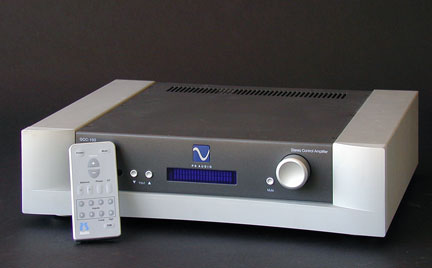
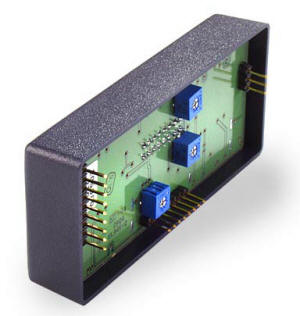 What's inside the Gain
Cell? Other than to note its all analog circuitry, PS Audio quite coyly
won't tell. They've potted the goods in epoxy resin to frustrate the curious
and the competition, and declare "we're not going to publish what's inside
nor do we intend to patent it." (The lawyers in the audience are now heard
muttering "or maybe they can't…"). My own guess is that it's simply your
basic straight wire with gain in parallel with a Tice clock. How else do you
get specs like frequency response from 1Hz to 50 kHz with 100dB + S/N ratio,
at .005% THD+noise?
What's inside the Gain
Cell? Other than to note its all analog circuitry, PS Audio quite coyly
won't tell. They've potted the goods in epoxy resin to frustrate the curious
and the competition, and declare "we're not going to publish what's inside
nor do we intend to patent it." (The lawyers in the audience are now heard
muttering "or maybe they can't…"). My own guess is that it's simply your
basic straight wire with gain in parallel with a Tice clock. How else do you
get specs like frequency response from 1Hz to 50 kHz with 100dB + S/N ratio,
at .005% THD+noise?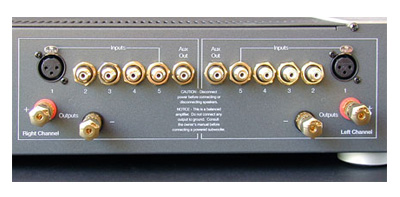 At a svelte 26 lbs.,
the GCC 100 was easily slipped into the equipment rack. Hooking gear up was
oddly non-intuitive, however. 99% of the equipment I've ever installed has
either stacked the L and R RCA jacks one atop the other or adjacent to each
other. But the GC is a dual mono design, with the L and R Gain Cells
installed side by side across the back panel. The RCAs are attached to the
Gain Cells in mirror image order. In other words, the innermost jacks are
the outputs for a subwoofer or bi-amping, the next set outward left and
right are inputs 5, then 4, and so on until one reaches the balanced input
XLR sockets at the outer end of each row, which turn out to be input 1.
While there are a few disc players and phono stages with balanced outputs,
it seemed odd to have to always cycle past the XLR input to get to the RCAs
with the remote. Perhaps McGowan has something special in mind for them …like
maybe a balanced output phono stage, me betcha.
At a svelte 26 lbs.,
the GCC 100 was easily slipped into the equipment rack. Hooking gear up was
oddly non-intuitive, however. 99% of the equipment I've ever installed has
either stacked the L and R RCA jacks one atop the other or adjacent to each
other. But the GC is a dual mono design, with the L and R Gain Cells
installed side by side across the back panel. The RCAs are attached to the
Gain Cells in mirror image order. In other words, the innermost jacks are
the outputs for a subwoofer or bi-amping, the next set outward left and
right are inputs 5, then 4, and so on until one reaches the balanced input
XLR sockets at the outer end of each row, which turn out to be input 1.
While there are a few disc players and phono stages with balanced outputs,
it seemed odd to have to always cycle past the XLR input to get to the RCAs
with the remote. Perhaps McGowan has something special in mind for them …like
maybe a balanced output phono stage, me betcha.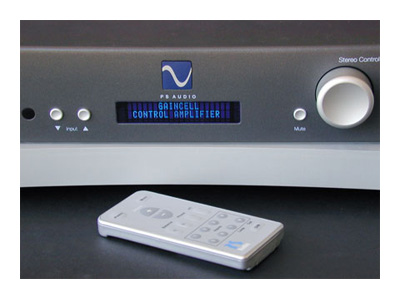 The front panel is
better thought out. The small mute button is conveniently just to the left
of the un-marked or detented "volume" knob, the level indicated numerically
on the small central LED panel. The two buttons to the left march you up or
down through the inputs, and allow the inputs to be named and adjusted in
level for gain-matching between sources. You can designate one input "HT"
which turns the variable gain off and allows the GCC to function as a simple
power amp in a surround system. Other than the remote sensor, that's it.
(P.S., PS: plenty of room for that mono button). The two-tone fascia will
blend with most other equipment, and the sculptured effect is pleasant, but
no one would think it "precision machined from a solid billet of unobtanium"
ala Chord or Boulder audio/architecture. You power up by pushing the PS
logo; the LED display is dimmable and offable by the remote, but the
luminous blue bar below it (a friend thought it inspired by Low-Rider
license plate neon) is controlled by a separate rear panel switch.
The front panel is
better thought out. The small mute button is conveniently just to the left
of the un-marked or detented "volume" knob, the level indicated numerically
on the small central LED panel. The two buttons to the left march you up or
down through the inputs, and allow the inputs to be named and adjusted in
level for gain-matching between sources. You can designate one input "HT"
which turns the variable gain off and allows the GCC to function as a simple
power amp in a surround system. Other than the remote sensor, that's it.
(P.S., PS: plenty of room for that mono button). The two-tone fascia will
blend with most other equipment, and the sculptured effect is pleasant, but
no one would think it "precision machined from a solid billet of unobtanium"
ala Chord or Boulder audio/architecture. You power up by pushing the PS
logo; the LED display is dimmable and offable by the remote, but the
luminous blue bar below it (a friend thought it inspired by Low-Rider
license plate neon) is controlled by a separate rear panel switch.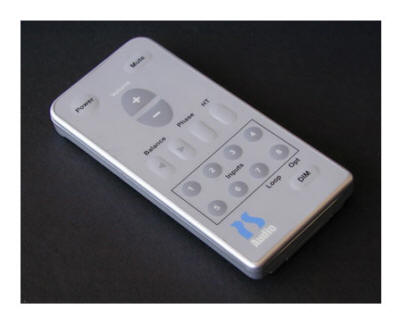 The remote is where
the main action is. About the size of an Altoids Mints tin, there are
buttons for level and balance (0.1 dB steps), input selection, the
phase/polarity switch, display dimming and output muting. Unfortunately, it
must be fairly accurately aimed. Personally, I would also like to be able to
control the size of the alphanumeric display, not just the brightness.
The remote is where
the main action is. About the size of an Altoids Mints tin, there are
buttons for level and balance (0.1 dB steps), input selection, the
phase/polarity switch, display dimming and output muting. Unfortunately, it
must be fairly accurately aimed. Personally, I would also like to be able to
control the size of the alphanumeric display, not just the brightness.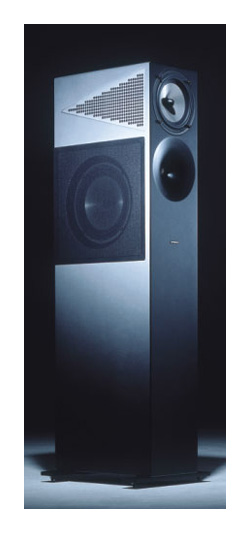 For some reason, the
GCC seemed to exacerbate the differences between interconnects and speaker
cables. The more accurate and refined the speaker, the more obvious the
colorations. The aforementioned Nordost Red Dawn II cable literally sucked
when bi-wiring the amp and the similarly revelatory and revealing Amphion
Xenons: the mid-bass through lower mid-range seemed to evaporate at the
expense of a too forward upper midrange/treble. This was not a situation I
would choose to live with, but the combination of the teensy "94% speed of
light" conductors and fast, stiff aluminum drivers certainly highlighted the
GCC's grainless HF extension and articulate bass. Now these are not
particularly "lean" speakers, nor are they a difficult load for the amp–the
impedance never drops below 7 ohms–but bi-wiring presents the load as a
little differently than does a single run. It's also no secret that Nordost
cables can seem bass-light in some systems. A quick fix turned out to be $70
worth of the Speltz "Anti-Cables" (for more information see the review by
Fown-Ming Tien at
For some reason, the
GCC seemed to exacerbate the differences between interconnects and speaker
cables. The more accurate and refined the speaker, the more obvious the
colorations. The aforementioned Nordost Red Dawn II cable literally sucked
when bi-wiring the amp and the similarly revelatory and revealing Amphion
Xenons: the mid-bass through lower mid-range seemed to evaporate at the
expense of a too forward upper midrange/treble. This was not a situation I
would choose to live with, but the combination of the teensy "94% speed of
light" conductors and fast, stiff aluminum drivers certainly highlighted the
GCC's grainless HF extension and articulate bass. Now these are not
particularly "lean" speakers, nor are they a difficult load for the amp–the
impedance never drops below 7 ohms–but bi-wiring presents the load as a
little differently than does a single run. It's also no secret that Nordost
cables can seem bass-light in some systems. A quick fix turned out to be $70
worth of the Speltz "Anti-Cables" (for more information see the review by
Fown-Ming Tien at